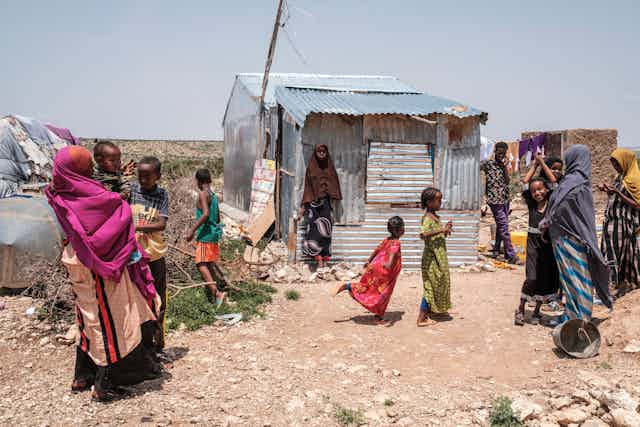Every day of the northern hemisphere’s summer in 2023 seems to bring a calamitous headline about the climate: heatwaves, wildfires, massive hailstorms.
Such scenes are set to become our global reality in the coming years. Scientists paint a grim picture of how human-induced climate change, combined with wider environmental degradation, will affect us all.
That, of course, includes children. However, research is still in its early stages on how, precisely, both climate change and environmental degradation relate to violence against children.
It is crucial to explore these potential intersections to spur academic and political movement in this area. Findings from such reviews, and further research that may emerge from it, could help to inform policies and interventions that can protect and support children, particularly those most vulnerable to the impacts of climate change and environmental shocks.
Our study
We conducted an extensive scoping review of the literature on the intersections of climate change, environmental degradation and violence against children, to see what’s known so far and what needs attention.
We explored both direct violence – physical, sexual and emotional – and structural violence; that is, rooted in inequitable and unjust systems and institutions. This approach allowed for a nuanced understanding of the implications for children in all countries. It also meant we could explore the causes and effects of climate change and environmental degradation in relation to systems, institutions, structures, norms and interactions.
The study identified five themes: hazards and disaster risk reduction; gender; climate-induced mobility or immobility; child labour; and health. What emerges clearly is that violence against children is not solely a phenomenon that intensifies during environmental shocks. It is deeply rooted in historical injustices, global systems and structures. That means it disproportionately affects those living in poverty.
1. Hazards and disaster risk reduction
Natural hazards, combined with large-scale humanitarian crises, pose immediate risks to health, life, property and the environment.
Studies have uncovered how increasing social, economic and emotional pressures in these situations expose children to higher risks of violence. This may occur in their homes or in relief shelters. It may be perpetrated by their peers, or by caregivers forcing them into labour because of the sudden need to rebuild or help make ends meet.
More knowledge is needed to inform integrated and culturally sensitive plans to protect children better from environmental hazards.
2. Gender
The effects of climate change and environmental degradation are not gender neutral. They can affect girls and boys differently. There is a growing body of work on gender-based violence and violence against women and girls in relation to climate change.
But this work tends to be centred on issues affecting female adults, conflating the term “gender” with “women”, without sufficient attention to the gendered effects of climate change on female and male children.
Existing research suggests that climate change can potentially exacerbate known drivers of child marriage in low- and lower-middle-income countries. But findings vary significantly by region. For example, there is an observed increase in child marriage motivated by the receipt of a bride price payment in sub-Saharan Africa during sudden periods of drought. In India, though, droughts have led to a decrease in child marriage to delay dowry payments.
Nuanced data about boys’ exposure to various forms of violence in the context of climate change is missing. That’s because studies tend to focus on males as perpetrators but not as victims of violence.
3. Mobility and immobility
The number of climate migrants is rising.
Research we reviewed on migration, displacement and relocation due to climate change, natural or human-induced hazards points to increased risks of violence against children within migrating families and higher exposure to it in camps and shelters. Also, separation from families or caregivers renders children and young people extremely vulnerable to violence.
Read more: Climate change, migration and urbanisation: patterns in sub-Saharan Africa
Meanwhile, immobility – when people cannot or do not want to move – has been associated in some studies with child abuse, injuries and overcrowding in slum areas.
Fear of violence in shelters can lead women to remain at home after natural hazards, increasing children’s risk of harm from the hazard or other forms of violence.
4. Child labour
Existing research indicates that child labour increases after natural hazards due to families’ reliance on child work and the absence of strategies to eliminate child labour entirely. Child labour is also prevalent in industries associated with climate change, such as agriculture, fisheries, mining, fashion and tourism.
The extent of child labour in this context, and its link to violence, remains inadequately explored in research, however, due to the hidden nature and contextual specificity of this issue.
5. Health
Children’s physical and mental health is affected by climate change. Natural hazards have been linked to poor health outcomes and increased mortality among children, particularly those younger than five.
There is emerging evidence that mental health issues, stemming from climate and environmental shocks, can lead to increased perpetration of violence against children, including domestic violence. Rising eco-anxiety among children and youth, caused by awareness of climate change and environmental degradation and fears of its consequences, adds to mental health problems.
Ways forward
By shedding light on the magnitude and pathways of these relationships, we want to underscore the urgent need for context-specific approaches and further research.
Understanding these interlinkages is essential for informing policies and interventions that can protect and support children, particularly those most vulnerable to the impacts of climate change and environmental shocks. By addressing the root causes of violence and prioritising the wellbeing of children in these crises, we can strive towards a safer and more sustainable future.


